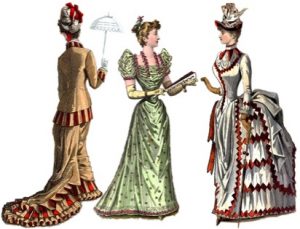When American men went off to fight the Germans and Japanese during World War II, women stepped in to manufacture weapons for fighting the enemy. The iconic character representing this time is Rosie the Riveter, a physically fit woman with a bandanna on her head and her arms flexed. To match this look, find a red bandanna and add to it some white polka dots (American History Costumes).
Then find a blue, button-up jumpsuit with a stiff collar. Wrap the bandanna around your entire head so only a bit of hair in the front sticks out past it. Tie the bandanna so the knot sticks up at the front of your head.

The first evidence of woven linen (flax) cloth dates back to the early 6th millennium BC in Turkey, but Western Europe did not produce any known flaxen cloth until about 3000 BC. Also found in Turkey is evidence of some of the first known fiber-dying. Red-dyed thread from 6000 BC was found at Catal Huyuk.
A colonial lady’s clothing consisted of Brunswick, cap, cape, Caraco, cloak, dress, fashionable undress, gown, hat, Jesuit, mitts or mittens, mob cap, muffs, patterns, petticoat, riding habit, shift, shoes, short gown, sleeve ruffles, stays, stomacher, Tucker and undress.
Stays were the essential foundation garment of the 18th century. They developed from the “boned bodies” of the 17th century, and in the 19th century were to become corsets. But just as the names of these garments changed, so did the shape and effect of the body. The fashionable 17th-century torso was an elongated tubular trunk, with little taper and encased the bosom.
Muffs were tube-like accessories used for keeping the hands warm, muffs were of various sizes as dictated by fashion. The stomacher was a triangular shaped piece of fabric used in the front of the gown to hold the gown together. Sometimes soft, but might be stiffened, it would be attached to the bodice lining by pins and tabs, hooks and eyes, or lacing.
In the 18th century mitts were elbow-length, fingerless gloves. Although there was a thumb, it was open and the fingers were left free. They were usually cut with peaked flaps over the knuckles. Embroidered floral motifs and fancy arm openings were popular adornments.
The oldest direct evidence of the use of shoes, however, are Native American sandals from about 5000 BC. Like all skins and hides, those that were used to create earlier footwear have been lost to the sands of time. The only way scientists know that early humankind was wearing shoes is the study of the bones. Apparently, the shape and placement of foot bones began to change 40,000-30,000 years ago. Shoes reduce the stress placed on lesser toes and cause them to do less work.
authentic historical costumes, historical costume ideas, historical figures costume ideas, historical costumes day, historical costumes for sale, historical figures costumes female, historical costumes patterns, easy historical costume ideas
